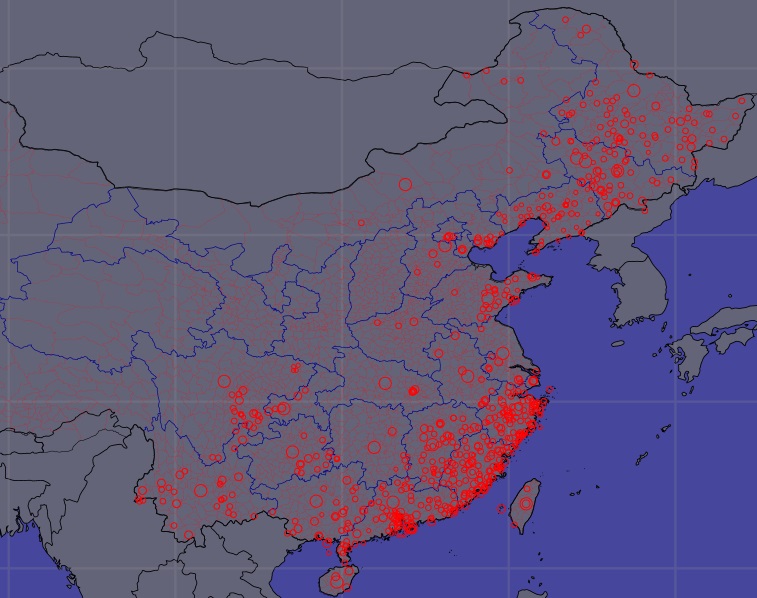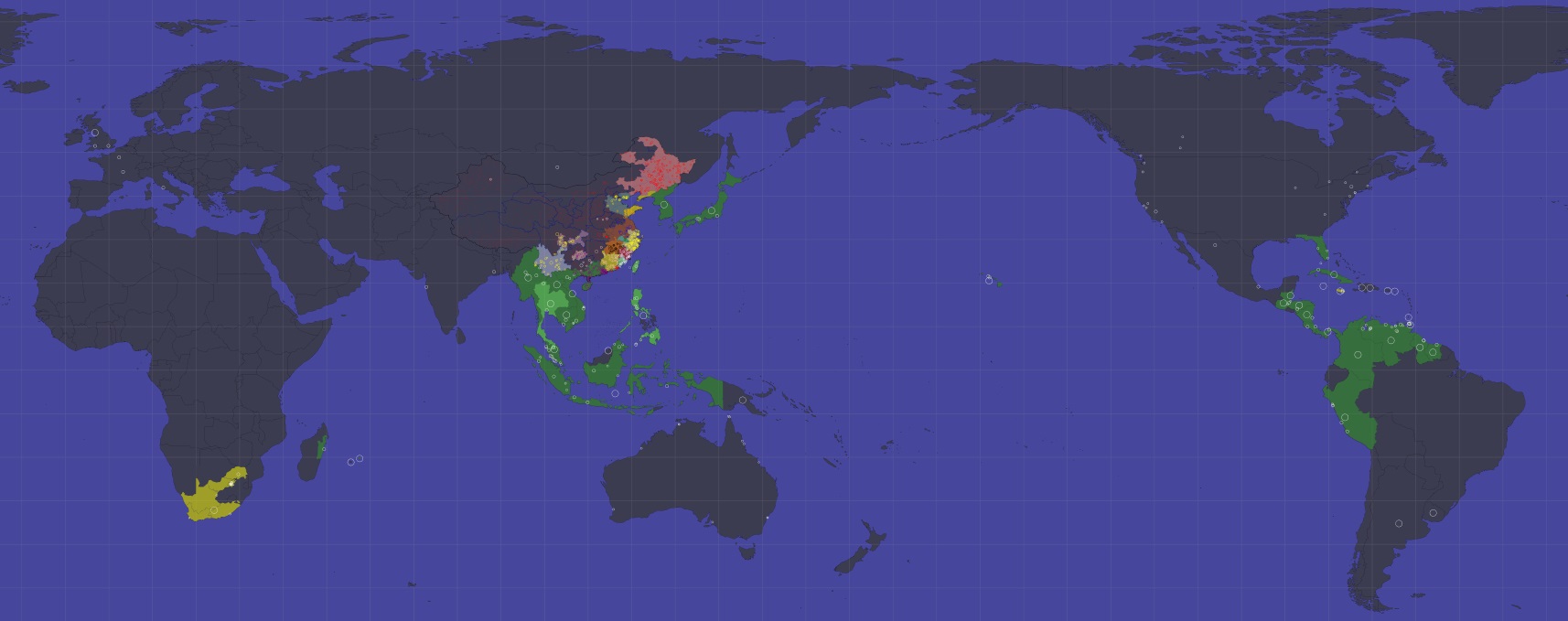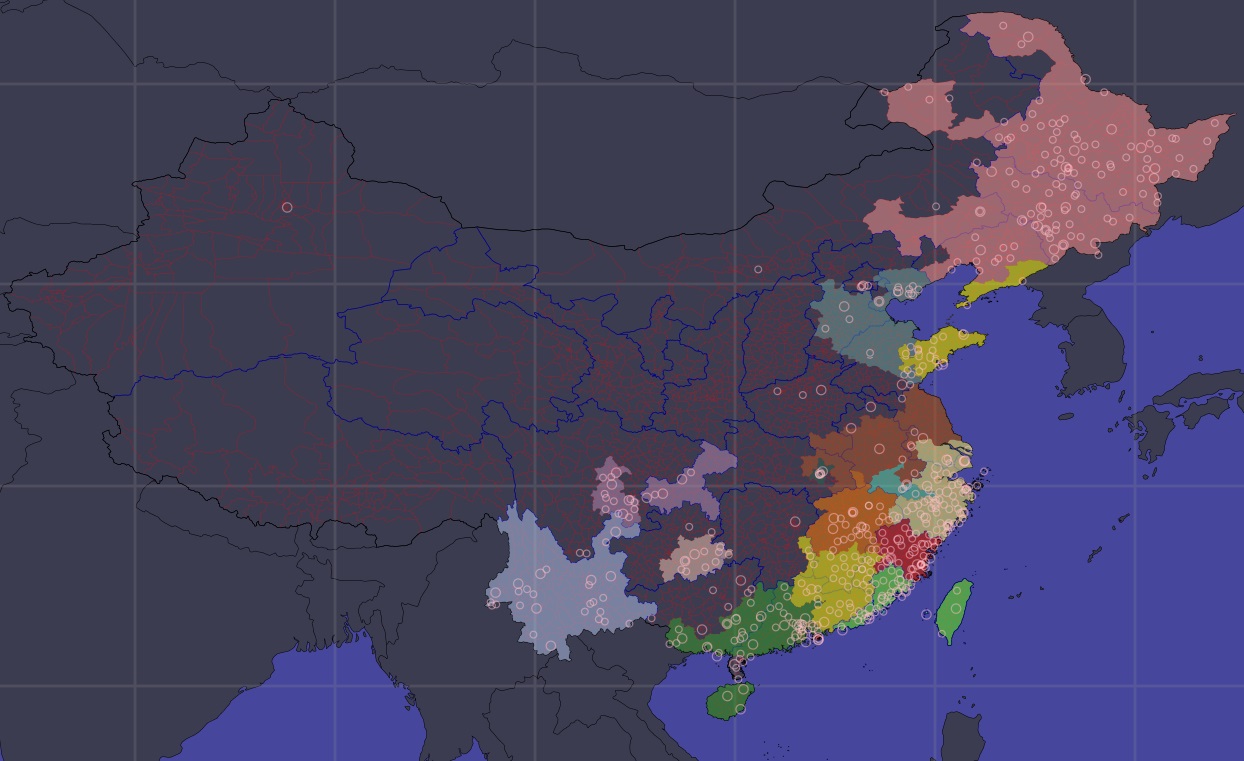The Game and the list
Hua-Hui is a gambling game of chinese origin.
It's based on the fictive biography of 36 characters.
The game propagates across China between the end of the 1700s and 1950.
It propagates too to South-East Asia, Americas, South-Africa, Australia etc...
The game and the list of names got adapted to local populations, and so, many variants exist.
Data available about this game are very unequal :
- in China, data is very precise geographically, chronogically a little less.
- in South-Eat Asia, data is very global, the main sources being travel memories from travellers and administrative documents.
- in the rest of the world, it really depends on the survival of the game in one form or another.
Here is a tentative reconstitution of the diffusion of the game and its list, and their variants.
- The game and the list
- Ways to play the game
- The game's origins and the game's names
▶The Game in China
 Here are the places where the game or one of its variants were played.
Here are the places where the game or one of its variants were played.
(The provinces' borders are the actual ones)
The main sources are
- local chronicles (县志, 市志, 鎮志, 区志...)
- local litterary and historical annals (文史资料)
- blogs, mémoires, etc...
- booklets, songs' repertoire, tickets, etc...
▶The Game in the world
Here are the places where the game or one of its variants were played.
Colored zones are regions where the game was played, white circle are places where the game was played but we found no proof that the game propagated to the whole region.
In China, colors represent the local variants (see below)
Out of China, colors represent the chinese local variant from which the locan version comes :
- dark green : cantonese
- light green : hokkien
- yellow : hakka

Ways to play the game
▶The original game
Initially, the organisation of the game is :
- the organiser (the banker) publish a list of 36 names which is used as basis for the game.
- for each round, he writes a few verses linked to one of these 36 characters and announces the date on which the name will be revealed.
- to gain the players' trust, the banker puts the winnning name in a public place : he writes it on a bamboo or a paper, and places it in a box or a handerchief and hangs it at the top of mast or to the beam of a public room.
- the players bid on the name they think they guess from the verses.
- At the announced date, the banker reveails the winning name, explains his verses et pay the winners.
The verses written by the banker related directly or indirectly to the winning name:
- The 36 characters had multiple relations amongst themselves :
- kinship ties
- bodies exchange (when they die, each character swaps their body with one of the other characters, creating 18 pairs)
- grouping into social categories
- and have many attributes:
- animals
- legendary or historical characters
- chinese calendar cycles
- dreams
For players to remember the 36 characters and their specificities, songs were written containing details about the characters.
Initially, booklets containing these songs were published, then, booklets detailing the biographies of the 36 characters and other features were published.
▶Game variants
From this basic rules, the propagation of the game will lead to numerous evolutions :
- change of the name of the game
- change in the list of names, names are changed, added or suppressed
- "localization" of the songs et names to adapt to the local dialect
- links between the characters will change, and their attributes too
- and, in certain cases, complete drop of "guessing" nature of the game to become a pure chance game.
In China et South-East Asia, there are 2 type of bankers :
- in cities, bankers are well established and the game is regularly organized (from once a week upto 3 times a day)
- on the country side, bankers are travelling from village to village, staying a few days in each, so the game is less frequent
The game being essentially local, a lot of variants appear in some regions:
- in Zhejiang, each town seem to have it's own list
- in Guangdong, the list does'nt vary much all through the province.
This is probably due to the existence of print books :
- In Zhejiang, the first printed books appear about 1895 (mentionning by the way, the great disparity in the local lists)
- In Guangdong, booklets with the full description of the 36 characters appear before 1850, therefore "standardizing" the list
▶The modes of propagation of the game
They can be classified in differrent categories:
- natural propagation
- The game spreads to a neighbouring region without modification
- localization
- The game spreads to a neighbouring region by adaptating to the local dialect
- immigration
- The game spreads to a distant region by migrants who used to play in their region of origin
- exportation
- The game spreads to a population by adaptating to another language (this is often the case after the precedent type, immigrants introduce other immigrants or locals to the game)
- indirect
- A variant of the game is implanted in a region by someone who knows about the game and adapts it to his own need
In China, the variants are mainly due to the adaptation to local dialects: some aspects of the game remain constant in the region using a given dialect, the changes (other than linguistic) appear during "localizations" to neighboring dialects.
In most of the cases, outside Asia, the logic of the propagation is :
The coolies import the game and play amongst themselves, then locals and/or other immigrants get interested and "translate" the game in their own language.
▶The families of variants and their relationships
Map of China with the main dialects in which the game has been adapted.
1775 Hokkien - 閩南語
1790 Hakka - 客家语
1790 Yue - 粤语
1790 Eastern Min - 閩東語
1795 Wu (Zhejiang/Shanghai) - 吳語
1850 Huizhou - 徽州话
1850 Jiangsu/Annhui - 下江官话/江淮官话
1835 Jiaoliao (Shandong/Liaoning) - 胶辽官話
1845 Jilu (Hebei) - 冀魯官話
1850 Gan - 贛語
1910 Wuhan
1910 part of Sichuan
1910 Yunnan
1920 Miao - 苗语
1920 Dongbei - 東北話/东北话
The game's origin is the South-Fujian/North Guangdong region speaking Hokkien/Min-Nan (Southern Min) (The variant spoken in North Guangdong is called Teochew).
The game propagate to the zones speaking this dialect (including south-west coastal area of Taiwan) and then :
- in the south-west direction to the Cantonese (Yue) speaking area,
- in the north-west direction to the Hakka speaking area,
- in the north-east direction to the Min speaking area.
All variants of the game come from one of these 4 variants (Hokkien/Teochew, Cantonese, Hakka, Min).
- Inside China
- The Min variant is the origin of the variants found in East and North China :
- First the Wu-speaking zone is infected (Zhejiang, South Jiangsu, including Shanghai),
- Then the Shandong peninsula and the south-east of Liaoning (speaking mandarin Jiao-Liao),
- and finally the rest of Shandong and part of Hebei (mainly Tianjin, Beijing and Tangshan)
- Around 1920, under the regim of the warlords (Beiyang 北洋政府), a new version propagate to the whole north-east of China.
- The Cantonse version propagates to South-West China (Yunnan, Sichuan, Guizhou).
- The Hakka version propagates, following the steps of the Taiping revolt :
- to North Jiangxi (speaking the Gan dialect).
- then the North Jiangsu and Anhui (speaking mandarin of Lower-Yanhzi),
- Outside China, the game propagates to South-East Asia by the means of the Chinese communities installed there, and all across the world in the colonies of the western countries that have abandoned slavery, and "import" Chinese people as labor (coolies).
(In some regions, the origins are multiple i.e. in Indonesia, the game has Teochew's origins as well as Hakka's).
- The Hokkien variant propagates :
- to the North-Philippines, under the name of Jueteng (or Hueteng, or Huweteng, 花当), where it will become the national game.
- to Malaisia (Kelantan) under de name of Hwa-Hwee (transliteration of the pronunciation of 花会).
- The Teochew variant propagates :
- to Indonesia (Teochew), under de name of Hwa-Hwee (transliteration of the pronunciation of 花会).
- to Thailand, where the king legalizes and sells the rights to organize the game, in order to relaunch the economy and promote alphabetisation.
- to Suriname,
- and to Trinidad.
- the Hakka variant propagates :
- to Indonesia,
- to South-Africa,
- to Jamaica,
- the Yue-Cantonese variant propagates :
- to South-East Asia : Burma, Laos, Cambodia, Vietnam,
- in the Indian Ocean : Madagascar and Mauritius,
- in the Pacific Ocean : Australia, Hawaii, Japan, Korea
- to Americas : Canada, USA, Cuba, Panama, Guyana, Venezuela, Peru.
So, these is two large families :
- the Teochew/Cantonese/Hakka family which propagates in a few places inside China, and in many places abroad.
- the Hokkien/Min family which propagates mainly inside China, and a few communities of South-East Asia
▶General outlook on the evolution of the game and it's lists
- Like explained above the game was initially a litterary game : from a few verses, players had to guess the name they were related to.
- Later, with the publishing of booklets describing the 36 characters, an esoteric dimension was introduced in the way of playing : people believed that their dreams or everyday events were a clue to the winning name.
- To make the game accessible to non-chinese speaking players, the list of names was replaced by a list of animals and/or objects and booklets were translated and expanded.
These associations between numbers and dreams became very common in many places, becoming a kind of slang (cf Mauritius, Japan, Indonesia, etc...).
- The next step is the abandon of the clues : gamblers had only their dreams to get a clue to the winning name/number.
Bankers relied on local lotteries for gettin a 'random number' : the players bid on the last 2, 3 or 4 digits of the winning number of a well-known lottery.
Bankers published booklets linking the 100, 1000 ou 10000 numbers to dreams (i.e. the 2D, 3D or 4D lotteries).
The game's origins and the game's names
▶The Game's and List's origins
The origins of the game principle and of the list are unknown.
Here are the origins proposed by different authors (more or less credible ...) :
- The game was invented by the first Emperor of China for financing the building of the Great Wall (this doubtful theory is cited in Indonesia and Korea)
- The game comes from Ningbo in Zhejiang where the list consists of 34 names, in Shanghai 2 names were added : the Shanghai et the Ningbo list have the same numbering, but the 2 extra characters have number 2 and 4 so in fact, the Fujian list propagates to Zhejiang and Shanghai, but in Zhejiang 2 names were dropped (See the reason below...)
- 方阿哲 tells about a game called 荷步会捻 played in 云霄 (a district of 漳州), whose principle was to guess of the 64 generals' name.
The game evolved, the 64 names' list being replaced by a 36 or 38 names' list
- The 36 names' list is the codenames' list of the founders of the 天地会 secret society (founded in 1762 near 漳州, considered to be the origin of the triads) whose goal was the overthrow the Qing (Mandchous) et restore the Ming (Han).
This theory comes from the discovery of a document linking the 36 names of the game to the 36 historical characters.
It is known that the secret societies at these times used a lot of secret codes including riddles.
It would explain the name of the game : 花会 would be a contraction for 花名会, 花名 meaning nickname in South-China, 会 meaning assembly.
The two last theories link the game to the city 漳州 and its surrounding.
▶The game's names
In China, the game is known under many names, these various names became the local names of the game throughout the world.
| Chinese name | Meaning | Region | became...in these regions |
|---|
| 花會 |
花 flower
會 assembly, reunion |
China | Wahoy | Mindanao |
| Wah-Weh | Sabah |
| Fa-Fi | South Africa |
| Whe-Whe | Trinidad |
| Hwa-Hwee | Straits Settlement |
| Hoa-Hoee | Dutch East Indies |
| Hua-Hui | Indonesia |
| 花當/花当 |
花:flower, 當/当:?? |
Quanzhou (泉州 south-Fujian) |
Jueteng |
Luzon |
| 字花 |
字:character, 花:flower |
Yue version/Hakka version |
Chefa |
Guyana |
| Chiffa | Cuba |
| Chifa | Peru |
| Che-Fa | Hawaii |
| Chee-Fa | Australia |
| Gee-Far | US-East Coast, Montreal, British Columbia, Alberta |
| Tze-Fa | Chicago |
| 字華/チーハー | Japan |
| Chee-Fah | Malaya |
| 古人 |
the ancients, les elders |
Yue version |
Cổ nhơn |
Annam |
| 替 |
probably burmese name: 'hti' | Burma border |
| 梅花 | Plum blossom | Hainan Island |
| 花宝 | Flower treasuer | Yunnan and Sichuan |
| 押会 | probably a shortcut of 押花会:
'play hua-hui' | Shandong, Jilin, Heilongjiang and Liaoning |
| 压会 | 压 and 押 have the same pronunciation
a corrupt form of 押会 | Shandong, Jilin, Heilongjiang and Liaoning |
| 会局 | the place where the game is played or the game itself | Shandong, Jilin, Heilongjiang and Liaoning |
| 出会 | | Shandong, Jilin, Heilongjiang and Liaoning |
The reason of the different romanizations of the names 花會 and 字花 is that the pronunciations vary depending on the dialect used. (sources: dictionaries)
| Dialect | Variant | 字 | 花 | 會/会 |
|---|
| Mandarin | | zì | huā | huì |
|---|
| Yue | 粤语 | zi6 | faa1 | kui2 wui2 wui4 wui5 wui6 |
|---|
Hakka
客家话 | 沙头角腔 | su5 | fa1 | fui5 foi5 |
|---|
| 台湾四县腔 | sii5 cih5 | fa1 | fi5 woi5 |
| 客语拼音字汇 | si4 | fa1 | fi4 fui4 kai4 kuai4 voi4 |
| 客英字典 | sii5 cih5 | fa1 | fui5 kwai5 |
| 宝安腔 | su3 | fa1 | fui3 kai5 |
| 陆丰腔 | sii6 | fa1 | fui6 |
| 梅县腔 | se5 ze3 | fa1 | fi5 fui3 |
| 海陆丰腔 | sii6 cih6 | fa1 | fui6 woi6 |
| 东莞腔 | su5 | fa1 | fui3 |
| Teochew | 潮州话 | jī | huê1 hua1 | hue |
|---|
| Wu | 上海话 | zz | hwó | wé |
|---|
| Min | 廈門Amoy | jī | hōe | hoe |
|---|
| 福州 Foochow | che | hwa | hwoi |
| 福建 Hokkien | jē | hwa | höēy |
▶Variants of the list's names
As the game adapted locally, the names of the list changed - often using a homophonous character in the local dialect.
| Name | Local Variants | Written Variants |
|---|
| 太平 | | |
| 银玉 銀玉 | 根玉 艮玉 | |
| 吉品 | 极品 | |
| 扳桂 攀桂 | 板柜 板桂 拔桂 | |
| 逢春 | 红春 | |
| 荣生 榮生 | 永生 人生 仁生 云生 | |
| 日山 | 日出 入山 玉山 | |
| 安士 | 安寺 | |
| 元吉 | | |
| 三槐 | 三怀/三懷 | 三〇 |
| 九官 | 九宫 加官 | |
| 火官 | 伙官 金官 洪福 | |
| 万金 萬金 | | |
| 合海 | 河海 | |
| 汉云 漢雲 漢云 | 汗云 旱云 | |
| 月宝 月寶 | 曰宝 丑宝 | |
| 明珠 | | 明朱 |
| 天良 | 天龙 | |
| 必得 | 必德 | |
| 青元 | 青泉 清泉 音位 | |
| 青云 青雲 | | |
| 占魁 | 占奎 | 占斗 |
| 上招 | 上超 上昭 上召 | |
| 只得 | 只德 自得 志德 | |
| 天申 | | |
| 茂林 | | |
| 福孙 福孫 | 伏桑 福桑 福双 伏双 福生 | |
| 合同 | 合通 河通 | |
| 江祠 | 龙江 江词 江河 | |
| 正顺 正順 | | 正川 |
| 光明 | | |
| 志高 | 至高 志交 只高 | |
| 坤山 | 昆山 | |
| 井利 | 井力 井立 | |
| 有利 | | |
| 元贵 元貴 | 元桂 | |
| 音会 音會 | 观音 英台 阴街 阴会 高升 | |

 Here are the places where the game or one of its variants were played.
Here are the places where the game or one of its variants were played.

